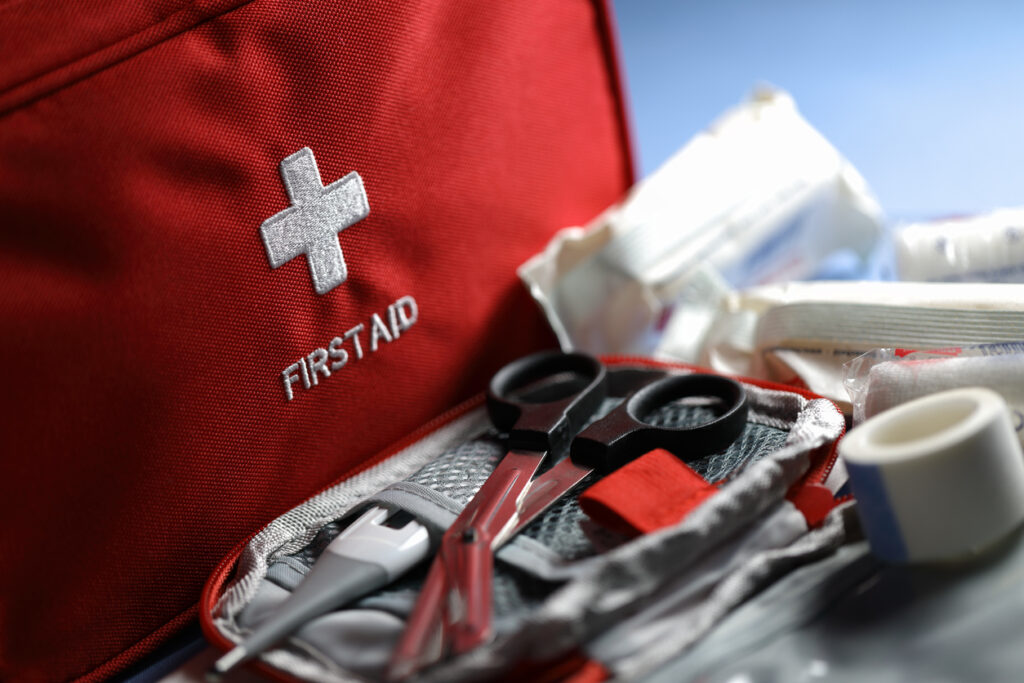The Covid-19 pandemic has affected all areas of the training sector, with face-to-face training sessions severely impacted. For those offering medical training, this has been a particular concern, since so much of this learning was offered in person in the past. In response to the crisis, St John Ambulance Cymru rolled out an online learning platform called The Online Learning Space, a free to access resource to aid skill retention through short interactive modules, mini courses and activities.
 Toria Acreman has been internal training manager at St John Ambulance Cymru since 2014, having started in customer services and worked in the training department. Here, she explains how a learner-focused approach has yielded success in the organisation’s transition to digital learning.
Toria Acreman has been internal training manager at St John Ambulance Cymru since 2014, having started in customer services and worked in the training department. Here, she explains how a learner-focused approach has yielded success in the organisation’s transition to digital learning.
TrainingZone: When the pandemic hit, you quickly had to rethink the standard face-to-face first aid training that St John Ambulance Cymru offers. What were some of the key challenges you were facing?
Toria: The main challenge was time constraints and a lack of suitably qualified personnel to help with the transition to digital learning. We had a job to do and we had to get it done quickly. I had help from a small team of two to help with course content, but the rest was down to me as the only person with experience using authoring tools. I had one week to make seven online courses. It was a pretty daunting thought at the time but I promised we would get it done as it was important to step up and help the country in a time of need. All of our courses have a full voice over to ensure they are also accessible for those with learning difficulties. I’m fortunate enough to have a good recording facility at home (a small perk of being married to a sound engineer). Quite often our courses have long and interesting medical terms which I struggle to pronounce but I always get there in the end with the help of Google!
TrainingZone: Your solution was to roll out an online learning platform, the Online Learning Space, and make it publically available. What did this entail and how did you achieve this at such speed?
Toria: Thankfully we already had an established learning management (LMS) system from the Charity Learning Consortium. Our staff and volunteers have been using the platform since 2017 and its popularity has increased dramatically over the years. This solid grounding meant everything was in place to quickly move content online when needed. We also had a small army of eager volunteers ready and waiting to complete any additional training needed of them. As soon as a course was completed I would upload this to our site and let our people know, using our closed Facebook group. This also meant our members weren’t bombarded with hours of online training to complete at once, but could complete one or two courses at a time allowing them to digest the information being taught to them. During the month of April our online course completions were up over 2000% on the same period last year.
TrainingZone: It’s difficult to imagine that a first aid training course can be completed online. Did you believe this was possible prior to the pandemic? Are there any limitations to a digital offering when it comes to first aid training?
Toria: I have been adding first aid content to our internal platform since it was launched in 2017. This has mainly been theory based topics as a source of important CPD. I never thought that I would be adding topics such as medical gases or patient diagnostics online, but here we are two months later and it’s working. It’s still vital that our people receive face-to-face sessions to practice the skills they have learnt online, but as we are operating on smaller class numbers, the shorter classroom sessions mean that our trainers are still able to cope. If we carried on delivering all of our training face-to-face, we would need to double our number of trainers to cope with the reduced classes sizes. In real terms this would mean training an extra 250 trainers, which would be too costly and impractical for the charity.
TrainingZone: What feedback have you received on the Online Learning Space so far?
Toria: Feedback has been incredibly positive to date. In general we have seen a huge increase in engagement with our LMS, our members are also taking advantage of the huge range of course content provided by the Charity Learning Consortium. Some of our members who have been shielding have enjoyed completing the online courses, as it is giving them something constructive to do in the house even if they aren’t able to help out on the front line.
TrainingZone: How do you think St John Ambulance Cymru’s training offering will change in a post-pandemic world?
Toria: First aid has always been and will always be a practical, hands on topic. I’m a firm believer in allowing the student to choose how they wish to learn, however, so have been slowly adding content to our LMS over the years. This pandemic has proven that it is possible to complete a lot of training virtually. Moving forward, I think a lot of our basic skill sets will remain online, backed up with scenario based classroom training. This will also free up our trainers to concentrate on the more complex training we offer, which is less frequently run but in huge demand.
Toria and St John Ambulance Cymru feature in a white paper focusing on the benefits of eLearning for charities. Find out more at clc.link/whitepaper.
Interested in this topic? Read Learning innovations: firing up your measurement capability.
The Covid-19 pandemic has affected all areas of the training sector, with face-to-face training sessions severely impacted. For those offering medical training, this has been a particular concern, since so much of this learning was offered in person in the past. In response to the crisis, St John Ambulance Cymru rolled out an online learning platform called The Online Learning Space, a free to access resource to aid skill retention through short interactive modules, mini courses and activities.
 Toria Acreman has been internal training manager at St John Ambulance Cymru since 2014, having started in customer services and worked in the training department. Here, she explains how a learner-focused approach has yielded success in the organisation’s transition to digital learning.
Toria Acreman has been internal training manager at St John Ambulance Cymru since 2014, having started in customer services and worked in the training department. Here, she explains how a learner-focused approach has yielded success in the organisation’s transition to digital learning.
TrainingZone: When the pandemic hit, you quickly had to rethink the standard face-to-face first aid training that St John Ambulance Cymru offers. What were some of the key challenges you were facing?
Toria: The main challenge was time constraints and a lack of suitably qualified personnel to help with the transition to digital learning. We had a job to do and we had to get it done quickly. I had help from a small team of two to help with course content, but the rest was down to me as the only person with experience using authoring tools. I had one week to make seven online courses. It was a pretty daunting thought at the time but I promised we would get it done as it was important to step up and help the country in a time of need. All of our courses have a full voice over to ensure they are also accessible for those with learning difficulties. I’m fortunate enough to have a good recording facility at home (a small perk of being married to a sound engineer). Quite often our courses have long and interesting medical terms which I struggle to pronounce but I always get there in the end with the help of Google!
TrainingZone: Your solution was to roll out an online learning platform, the Online Learning Space, and make it publically available. What did this entail and how did you achieve this at such speed?
Toria: Thankfully we already had an established learning management (LMS) system from the Charity Learning Consortium. Our staff and volunteers have been using the platform since 2017 and its popularity has increased dramatically over the years. This solid grounding meant everything was in place to quickly move content online when needed. We also had a small army of eager volunteers ready and waiting to complete any additional training needed of them. As soon as a course was completed I would upload this to our site and let our people know, using our closed Facebook group. This also meant our members weren't bombarded with hours of online training to complete at once, but could complete one or two courses at a time allowing them to digest the information being taught to them. During the month of April our online course completions were up over 2000% on the same period last year.
TrainingZone: It’s difficult to imagine that a first aid training course can be completed online. Did you believe this was possible prior to the pandemic? Are there any limitations to a digital offering when it comes to first aid training?
Toria: I have been adding first aid content to our internal platform since it was launched in 2017. This has mainly been theory based topics as a source of important CPD. I never thought that I would be adding topics such as medical gases or patient diagnostics online, but here we are two months later and it’s working. It’s still vital that our people receive face-to-face sessions to practice the skills they have learnt online, but as we are operating on smaller class numbers, the shorter classroom sessions mean that our trainers are still able to cope. If we carried on delivering all of our training face-to-face, we would need to double our number of trainers to cope with the reduced classes sizes. In real terms this would mean training an extra 250 trainers, which would be too costly and impractical for the charity.
TrainingZone: What feedback have you received on the Online Learning Space so far?
Toria: Feedback has been incredibly positive to date. In general we have seen a huge increase in engagement with our LMS, our members are also taking advantage of the huge range of course content provided by the Charity Learning Consortium. Some of our members who have been shielding have enjoyed completing the online courses, as it is giving them something constructive to do in the house even if they aren't able to help out on the front line.
TrainingZone: How do you think St John Ambulance Cymru’s training offering will change in a post-pandemic world?
Toria: First aid has always been and will always be a practical, hands on topic. I’m a firm believer in allowing the student to choose how they wish to learn, however, so have been slowly adding content to our LMS over the years. This pandemic has proven that it is possible to complete a lot of training virtually. Moving forward, I think a lot of our basic skill sets will remain online, backed up with scenario based classroom training. This will also free up our trainers to concentrate on the more complex training we offer, which is less frequently run but in huge demand.
Toria and St John Ambulance Cymru feature in a white paper focusing on the benefits of eLearning for charities. Find out more at clc.link/whitepaper.
Interested in this topic? Read Learning innovations: firing up your measurement capability.






